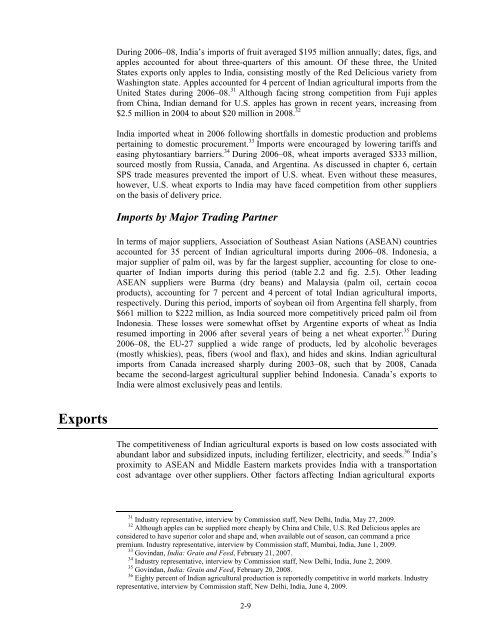India: Effects of Tariffs and Nontariff Measures on U.S. ... - USITC
India: Effects of Tariffs and Nontariff Measures on U.S. ... - USITC
India: Effects of Tariffs and Nontariff Measures on U.S. ... - USITC
Create successful ePaper yourself
Turn your PDF publications into a flip-book with our unique Google optimized e-Paper software.
During 2006–08, <str<strong>on</strong>g>India</str<strong>on</strong>g>’s imports <str<strong>on</strong>g>of</str<strong>on</strong>g> fruit averaged $195 milli<strong>on</strong> annually; dates, figs, <str<strong>on</strong>g>and</str<strong>on</strong>g><br />
apples accounted for about three-quarters <str<strong>on</strong>g>of</str<strong>on</strong>g> this amount. Of these three, the United<br />
States exports <strong>on</strong>ly apples to <str<strong>on</strong>g>India</str<strong>on</strong>g>, c<strong>on</strong>sisting mostly <str<strong>on</strong>g>of</str<strong>on</strong>g> the Red Delicious variety from<br />
Washingt<strong>on</strong> state. Apples accounted for 4 percent <str<strong>on</strong>g>of</str<strong>on</strong>g> <str<strong>on</strong>g>India</str<strong>on</strong>g>n agricultural imports from the<br />
United States during 2006–08. 31 Although facing str<strong>on</strong>g competiti<strong>on</strong> from Fuji apples<br />
from China, <str<strong>on</strong>g>India</str<strong>on</strong>g>n dem<str<strong>on</strong>g>and</str<strong>on</strong>g> for U.S. apples has grown in recent years, increasing from<br />
$2.5 milli<strong>on</strong> in 2004 to about $20 milli<strong>on</strong> in 2008. 32<br />
<str<strong>on</strong>g>India</str<strong>on</strong>g> imported wheat in 2006 following shortfalls in domestic producti<strong>on</strong> <str<strong>on</strong>g>and</str<strong>on</strong>g> problems<br />
pertaining to domestic procurement. 33 Imports were encouraged by lowering tariffs <str<strong>on</strong>g>and</str<strong>on</strong>g><br />
easing phytosantiary barriers. 34 During 2006–08, wheat imports averaged $333 milli<strong>on</strong>,<br />
sourced mostly from Russia, Canada, <str<strong>on</strong>g>and</str<strong>on</strong>g> Argentina. As discussed in chapter 6, certain<br />
SPS trade measures prevented the import <str<strong>on</strong>g>of</str<strong>on</strong>g> U.S. wheat. Even without these measures,<br />
however, U.S. wheat exports to <str<strong>on</strong>g>India</str<strong>on</strong>g> may have faced competiti<strong>on</strong> from other suppliers<br />
<strong>on</strong> the basis <str<strong>on</strong>g>of</str<strong>on</strong>g> delivery price.<br />
Imports by Major Trading Partner<br />
In terms <str<strong>on</strong>g>of</str<strong>on</strong>g> major suppliers, Associati<strong>on</strong> <str<strong>on</strong>g>of</str<strong>on</strong>g> Southeast Asian Nati<strong>on</strong>s (ASEAN) countries<br />
accounted for 35 percent <str<strong>on</strong>g>of</str<strong>on</strong>g> <str<strong>on</strong>g>India</str<strong>on</strong>g>n agricultural imports during 2006–08. Ind<strong>on</strong>esia, a<br />
major supplier <str<strong>on</strong>g>of</str<strong>on</strong>g> palm oil, was by far the largest supplier, accounting for close to <strong>on</strong>equarter<br />
<str<strong>on</strong>g>of</str<strong>on</strong>g> <str<strong>on</strong>g>India</str<strong>on</strong>g>n imports during this period (table 2.2 <str<strong>on</strong>g>and</str<strong>on</strong>g> fig. 2.5). Other leading<br />
ASEAN suppliers were Burma (dry beans) <str<strong>on</strong>g>and</str<strong>on</strong>g> Malaysia (palm oil, certain cocoa<br />
products), accounting for 7 percent <str<strong>on</strong>g>and</str<strong>on</strong>g> 4 percent <str<strong>on</strong>g>of</str<strong>on</strong>g> total <str<strong>on</strong>g>India</str<strong>on</strong>g>n agricultural imports,<br />
respectively. During this period, imports <str<strong>on</strong>g>of</str<strong>on</strong>g> soybean oil from Argentina fell sharply, from<br />
$661 milli<strong>on</strong> to $222 milli<strong>on</strong>, as <str<strong>on</strong>g>India</str<strong>on</strong>g> sourced more competitively priced palm oil from<br />
Ind<strong>on</strong>esia. These losses were somewhat <str<strong>on</strong>g>of</str<strong>on</strong>g>fset by Argentine exports <str<strong>on</strong>g>of</str<strong>on</strong>g> wheat as <str<strong>on</strong>g>India</str<strong>on</strong>g><br />
resumed importing in 2006 after several years <str<strong>on</strong>g>of</str<strong>on</strong>g> being a net wheat exporter. 35 During<br />
2006–08, the EU-27 supplied a wide range <str<strong>on</strong>g>of</str<strong>on</strong>g> products, led by alcoholic beverages<br />
(mostly whiskies), peas, fibers (wool <str<strong>on</strong>g>and</str<strong>on</strong>g> flax), <str<strong>on</strong>g>and</str<strong>on</strong>g> hides <str<strong>on</strong>g>and</str<strong>on</strong>g> skins. <str<strong>on</strong>g>India</str<strong>on</strong>g>n agricultural<br />
imports from Canada increased sharply during 2003–08, such that by 2008, Canada<br />
became the sec<strong>on</strong>d-largest agricultural supplier behind Ind<strong>on</strong>esia. Canada’s exports to<br />
<str<strong>on</strong>g>India</str<strong>on</strong>g> were almost exclusively peas <str<strong>on</strong>g>and</str<strong>on</strong>g> lentils.<br />
Exports<br />
The competitiveness <str<strong>on</strong>g>of</str<strong>on</strong>g> <str<strong>on</strong>g>India</str<strong>on</strong>g>n agricultural exports is based <strong>on</strong> low costs associated with<br />
abundant labor <str<strong>on</strong>g>and</str<strong>on</strong>g> subsidized inputs, including fertilizer, electricity, <str<strong>on</strong>g>and</str<strong>on</strong>g> seeds. 36 <str<strong>on</strong>g>India</str<strong>on</strong>g>’s<br />
proximity to ASEAN <str<strong>on</strong>g>and</str<strong>on</strong>g> Middle Eastern markets provides <str<strong>on</strong>g>India</str<strong>on</strong>g> with a transportati<strong>on</strong><br />
cost advantage over other suppliers. Other factors affecting <str<strong>on</strong>g>India</str<strong>on</strong>g>n agricultural exports<br />
31 Industry representative, interview by Commissi<strong>on</strong> staff, New Delhi, <str<strong>on</strong>g>India</str<strong>on</strong>g>, May 27, 2009.<br />
32 Although apples can be supplied more cheaply by China <str<strong>on</strong>g>and</str<strong>on</strong>g> Chile, U.S. Red Delicious apples are<br />
c<strong>on</strong>sidered to have superior color <str<strong>on</strong>g>and</str<strong>on</strong>g> shape <str<strong>on</strong>g>and</str<strong>on</strong>g>, when available out <str<strong>on</strong>g>of</str<strong>on</strong>g> seas<strong>on</strong>, can comm<str<strong>on</strong>g>and</str<strong>on</strong>g> a price<br />
premium. Industry representative, interview by Commissi<strong>on</strong> staff, Mumbai, <str<strong>on</strong>g>India</str<strong>on</strong>g>, June 1, 2009.<br />
33 Govindan, <str<strong>on</strong>g>India</str<strong>on</strong>g>: Grain <str<strong>on</strong>g>and</str<strong>on</strong>g> Feed, February 21, 2007.<br />
34 Industry representative, interview by Commissi<strong>on</strong> staff, New Delhi, <str<strong>on</strong>g>India</str<strong>on</strong>g>, June 2, 2009.<br />
35 Govindan, <str<strong>on</strong>g>India</str<strong>on</strong>g>: Grain <str<strong>on</strong>g>and</str<strong>on</strong>g> Feed, February 20, 2008.<br />
36 Eighty percent <str<strong>on</strong>g>of</str<strong>on</strong>g> <str<strong>on</strong>g>India</str<strong>on</strong>g>n agricultural producti<strong>on</strong> is reportedly competitive in world markets. Industry<br />
representative, interview by Commissi<strong>on</strong> staff, New Delhi, <str<strong>on</strong>g>India</str<strong>on</strong>g>, June 4, 2009.<br />
2-9

















